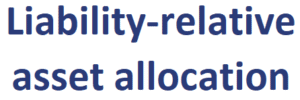Liability-relative asset allocation approaches
There are at least three liability-relative asset allocation approaches that investors can use. These three approaches are surplus optimization, the two-portfolio approach, and the integrated asset-liability approach. The first approach is an extension of mean-variance optimization. The second approach creates two sub-portfolios, a hedging portfolio and a return-seeking portfolio. Finally, the third approach integrates the assets and the liabilities and performs a joint optimization
On this page, we discuss all three approaches in more detail and we discuss the advantages and limitations of the approaches.
Surplus optimization
Surplus optimization is an extension of mean-variance optimization in which we determine an efficient frontier based on the surplus with its volatility as the measure of risk. This volatility can be expressed in money or in percentage terms.
We can define the surplus return as
In that case, the objective function becomes
where is the expected surplus return and
is the variance of the surplus return. We then proceed with MVO, except we also included the expected returns and variances of the liabilities.
There are a number of methods we can use to estimate the expected returns and variances of the liabilities:
- Make the assumption that the liabilities behave like corporate bonds and the liability inputs can be estimated using the expected returns and volatility of corporate bonds
- Use a factor approach and identify the common factors that affect both the asset classes and the liabilities
Two-portfolio approach
The two-portfolio approach, which is also known as the hedging or return-seeking approach is a very straight-forward approach. We create an asset allocation that hedges the liabilities and the remainder is managed independently using MVO.
The hedging portfolio can be created using cash-flow matching, duration-matching, and immunization. This approach is most often used for insurance companies and overfunded pension plans.
The approach can also be modified as follows:
- partially hedge the liabilities and allocating more capital to the return-seeking portfolio
- increasing the allocation to the hedging portfolio as the funding ratio and the surplus increase
Both these variations are more aggressive than completely hedging the liabilities.
The limitations of the approach are:
- if the funding ratio < 1, it is difficult to create a hedging portfolio that completely hedges the liabilities
- a hedging portfolio may not be available to hedge certain kinds of risks.
Integrated Asset-liability approach
This approach is more sophisticated in that it does not make the hedging and asset allocation separately. Instead, the decisions about the composition of the liabilities are made jointly with the asset allocation decisions. There is also a continuous feedback loop between the two. This approach requires a multi period model. An example of this approach is a bank that chooses the optimal mix of assets and liabilities to meet its objectives.
Summary
We discussed three liability-relative asset allocation approaches that are used by banks, insurers, and hedge funds.

